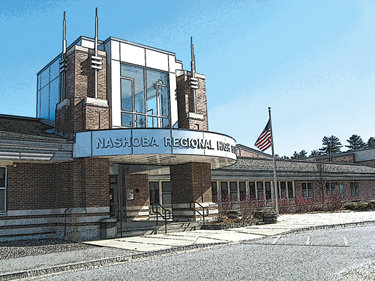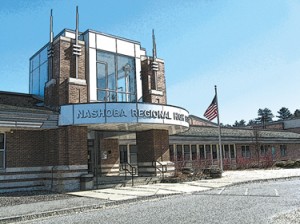
By Ann Needle
Wednesday’s Nashoba School Committee meeting focused on two developing topics across the district, along with some unexpected savings in store for Nashoba’s towns.
One topic receiving substantial attention from Nashoba administration is the NEASC report (New England Association of Schools and Colleges), released earlier in the school year. This detailed study of Nashoba Regional High School’s health will be followed later this fall by ratings and re-accreditation status, which is reviewed every 10 years.
In his summary of NEASC’s findings, NRHS Principal Dr. Parry Graham stressed that, “Overall, the NEASC report was a very positive testament to our staff and students.” Graham also pointed to several key findings and recommendations by NEASC he believed will have the biggest impact on the high school’s culture and the district’s budget. Among these are the need to more closely target professional development time to specific staff needs, develop more effective approaches to teaching students needing alternative education, and revamping the role of the department heads to allow for more decision-making responsibilities.
Graham pointed to the last two recommendations as likely to involve district spending. Putting a full, formal alternative education plan in place—often aimed at students at risk of not graduating—could mean anything from adding stipend positions for after-school programs, to more full- or part-time faculty for new classes. Graham said he expects about 25 students to take full advantage of such a program.
As for the departments heads, Graham noted they currently do not conduct such institutional tasks as evaluating teachers, and only teach one class less in a day than a full-time teacher, who handles 5. Granting department heads more authority and trimming their teaching time could, among other budget implications, mean updates to the teaching contract, he said.
Another big project for the district is the pilot Math program launched this year in the elementary grades. Interim STEM Coordinator Karen Benoit explained that the current Math curriculum, Everyday Math, needs to be supplemented by teachers in order to meet the MA State Curriculum Framework. And, there is no consistency between how each teacher and grade supplements these materials, she said. Therefore, the district is currently testing two Math pilot programs across segments of kindergarten through grade 5, aiming to find a curriculum source that is a better match to the MA standards.
To asses each pilot program’s success, Benoit said administration will consider whether student performance improves, using such measures as aimsweb (an online student assessment system) and teacher reports on the programs at the end of each trimester. She added that teachers and parents also will be surveyed in the spring. Nashoba should know by January which program is working well, and will make a final decision toward the end of the school year.
Though the district is hoping one or both pilots will work well, Benoit noted that if they do not, is still possible Nashoba will instead stay with Everyday Math, but will need to look at more consistent supplemental materials across classrooms.
According to Superintendent Michael Wood, the district has estimated the cost for any new curriculum at—very roughly–$150,000. However, this could vary depending on what materials are needed. He also mentioned that some materials would likely be paid for out of money set aside each year for curriculum or similar needs. Still, SC Chair Lorraine Romasco of Bolton remarked that, while she does not advocate penny-pinching on a curriculum, she would have liked to discuss this before the pilot phase, especially as the 2016/17 budget may be tight.
Re-Financing to Bring Savings
The SC unanimously voted to allow the district to re-finance its remaining debt for its last renovation of NRHS. According to Assistant Superintendent George King, about half of this debt is still outstanding. The refinancing will save Nashoba’s three towns a total of more than $211,000 over the remaining life of the bond, with savings ranging from a high of $25,516 in fiscal year 2017, to a low of $21,335 in 2022. King stressed that all savings will go toward reducing the district’s assessment to the towns.
In his report to the SC, Michael Wood noted that district nurses are working with the MA Dept. of Pubic Health on having Narcon available in their offices, and are going through training on administering the over-the-counter drug. When given, Narcon has a strong success rate in reversing drug overdoses as they happen.
Wood also announced that the Town of Stow has officially signed off with the MA School Building Authority on the Center School project, with all payment issues resolved.
Space continues to top the topics at NRHS, with Wood reporting that the district will move its Technology offices from the high school to the Emerson School to help carve out more space. And, in answering a question about when the assigned spaces of the student parking lot at NRHS can be used by anyone, Parry Graham said that any time outside of school hours—including right after school—is “fair game” for non-pass holders to use that lot.